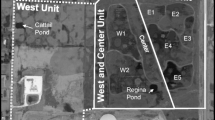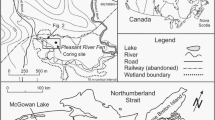Abstract
The Upper Mississippi Embayment (UME) ecoregion covers approximately 141,895 km2 and historically supported 9,712,455 ha of bottomland deciduous forests, swamps, bayous, and rivers. Only about 500 ha (< 0.01%) of pre-settlement bottomland hardwood forest habitat in the Mississippi Alluvial Valley (MAV) in the UME remained by the 1940s because the timber was clearcut and the wetlands drained for agriculture. By 1983 only a few scattered cypress-tupelo swamps remained. We studied the freshwater turtle community in Allred Lake, Missouri, a rare remnant of this ecosystem and compared these results to those from two other study sites in the MAV, Big Oak Tree State Park (BOTSP), Missouri, and Coldwater River National Wildlife Refuge (CRNWR), Mississippi. Species richness included six species commonly found throughout the MAV. One species (Red-eared Slider, Trachemys scripta elegans) dominated density and biomass in all three assemblages. The occurrence of the six species we studied in man-made restored wetlands such as those in BOTSP and CRNWR indicate these turtles would adapt to restored wetlands in the MAV in southeastern Missouri and elsewhere in the ecosystem. We provide information on habitat features that could be included in restoration design and construction that would benefit turtles. Given the ongoing worldwide decline of turtles, consideration of turtle ecology and behavior in wetland restoration projects in the MAV may be warranted.




Similar content being viewed by others
References
Allen JA, Keeland BD, Stanturf JA, Clewell AF, Kennedy HE Jr (2001) A guide to bottomland hardwood restoration. USDA, US Geol Surv Biol Res Infor Div Infor and Tech. Rep USGS/BRD/ITR-2000–0011, Gen Tech Rep. SRS-40
Bailey MA, Holmes JN, Buhlmann KA, Mitchell JC (2006) Habitat management guidelines for amphibians and reptiles in the southeastern United States. Partners in amphibian and reptile conservation, Tech. Publ. HMG-2
Buhlmann KA (1995) Habitat use, terrestrial movements, and conservation of the turtle Deirochelys reticularia. J Herpetol 29:173–181
Buhlmann KA, Gibbons JW (2001) Terrestrial habitat use by aquatic turtles from a seasonally fluctuating wetland: implications for wetland conservation boundaries. Chelonian Conserv Biol 4:115–127
Buhlmann KA, Osborn CP (2011) Use of an artificial nesting mound by wood turtles (Glyptemys insculpta): a tool for turtle conservation. Northeast Nat 18:315–334
Buhlmann KA, Vaughan MR (1991) Ecology of the turtle Pseudemys concinna in the New River, West Virginia. J Herpetol 25:72–78
Bury RB (1979) Population ecology of freshwater turtles. In: Harless M, Morelock H (eds) Turtles: perspectives and research. Wiley, New York, pp 571–602
Cagle FR (1939) A system for marking turtles for future identification. Copeia 1939:170–173
Cagle FR (1942) Turtle populations in southern Illinois. Copeia 1942:155–162
Cagle FR (1944) Home range homing behavior and migration in turtles. Misc Publ Mus Zool Univ Michigan 61:1–33
Clark HW, Southall JB (1920) Fresh-water turtles: a source of meat supply. U.S. Bureau Fisheries Document 889:4–20
Congdon JD, Tinkle DW, Breitenbach GL, Van Loben Sels RC (1983) Nesting ecology and hatching success of the turtle Emydoidea blandingi. Herpetologica 39:417–429
Congdon JD, Greene JL, Gibbons JW (1986) Biomass of freshwater turtles: a geographic comparison. Am Midl Nat 115:165–173
Donnelly MA, Guyer G (1994) Estimating population size. In: Heyer WR, Donnelly MA, McDiarmid RW, Hayek LC, Foster MS (eds) Measuring and monitoring biological diversity, standard methods for amphibians. Smithsonian Institution Press, Washington, DC, pp 183–205
Elbers JP, Moll D (2011) Ingestion by a freshwater turtle alters germination of bottomland hardwood seeds. Wetlands 31:757–761
Ernst CH, Lovich JE (2009) Turtles of the United States and Canada, 2nd edn. Johns Hopkins University Press, Baltimore
Gibbons JW (1970) Terrestrial activity and population dynamics of aquatic turtles. Am Midl Nat 83:404–414
Gibbons JW, Scott DE, Ryan TJ, Buhlmann KA, Tuberville TD, Metts BS, Greene JL, Mills T, Leiden Y, Poppy S, Winne CT (2000) The global decline of reptiles, déjá vu amphibians. BioScience 50:653–666
Glorioso BM, Vaughn AJ (2008) Demographics of the turtle population of Big Oak Tree State Park: implications for management and conservation. Report to Missouri Dept Nat Res, Jefferson City
Glorioso BM, Vaughn AL, Waddle JH (2010) The aquatic turtle assemblage inhabiting a highly altered landscape in southeast Missouri. J Fish Wild Manage 1:161–168
Harris LD (1984) Bottomland hardwoods: valuable, vanishing, vulnerable. Cooperative Extension Service, Institute of Food and Agricultural Sciences, University of Florida, Gainesville
Hinton TG, Scott DE (1990) Radioecological techniques for herpetology, with an emphasis on freshwater turtles. In: Gibbons JW (ed) Life history and ecology of the slider turtle. Smithsonian Institution Press, Washington, DC, pp 267–287
Hoffmann M, Hilton-Taylor C, Angulo A, Böhm M (2010) The impact of conservation on the status of the world’s vertebrates. Science 330:1503–1509
Iverson JB (1982) Biomass in turtle populations: a neglected subject. Oecologia 55:69–76
Janzow FT, Stauffer GF (1982) A survey of fishes and their habitat in the southeast Missouri lowlands. Project report-Nat Hist Sec, Missouri Department of Conservation, Jefferson City
Johnson TR (2000) The amphibians and reptiles of Missouri, 2nd edn. Missouri Department of Conservation, Jefferson City
Kingsbury BA, Gibson J (2012) Habitat management guidelines for amphibians and reptiles in the midwestern United States. Partners in amphibian and reptile conservation Tech Publ HMG-2, Montgomery, Alabama
Lagler KF, Applegate VC (1941) Relationship between the length and weight in the snapping turtle, Chelydra serpentina Linnaeus. Am Nat 77:476–478
Lindsay MK, Zhang Y, Forstner MJR, Hahn D (2013) Effects of the fresh-water turtle Trachemys scripta elegans on ecosystem functioning: an approach in experimental ponds. Amphib-Reptil 34:75–84
Lovich JE, Ennen JR, Agha M, Gibbons JW (2018) Where have all the turtles gone, and why does it matter? BioScience 68:771–781
Mali I, Vandewege MW, Davis SK, Forstner MJR (2014) Magnitude of the freshwater turtle exports from the US: long term trends and early effects of newly implemented harvest management regimes. PLoS ONE 9:e86478
McWilliams WH, Rosson JF Jr (1990) Composition and vulnerability of bottomland hardwood forests of the Coastal Plain Province in the south-central United States. For Ecol Manage 33(34):485–501
MDC (1988) Lighting the way: a plan for conservation. Missouri Department of Conservation, Jefferson City, pp 1–20
MDC (2016) Wilhelmina conservation area: ten-year area plan FY 2016–2025. Missouri Department of Conservation, Jefferson City
MDC (2018) Corkwood conservation area: ten-year area plan FY 2018–2027. Missouri Department of Conservation, Jefferson City
MDC (2019) Allred Lake natural area. https://nature.mdc.mo.gov/discover-nature/places/allred-lake. Accessed 19 Jan 2019
MDC (2019) Ducks unlimited homepage. Ducks unlimited/Missouri Department of Conservation. https://mdc.mo.gov/contact-engage/donate/ducks-unlimited. Accessed 19 Jan 2019
Morgan WJ (1983) Hotspots tracks and the early rifting of the Atlantic. Tectonphysics 94:123–139
Moss B (2017) Marine reptiles, birds and mammals and nutrient transfers among the seas and the land: an appraisal of current knowledge. J Exp Mar Biol Ecol 492:63–80
Noss RF, Platt JW, Sorrie BA, Weakley AS, Means DB, Costanza J, Peet RK (2014) How global biodiversity hotspots may go unrecognized: lessons from the North American Coastal Plain. Div Dist 21:236–244
Overton WS, Davis DE (1969) Estimating the number of animals in wildlife populations. In: Giles RH Jr (ed) Wildlife management techniques. The Wildlife Society, Washington, DC, pp 403–455
Parker WS (1990) Colonization of a newly constructed farm pond in Mississippi by slider turtles and comparisons with established populations. In: Gibbons JW (ed) Life history and ecology of the slider turtle. Smithsonian Institution Press, Washington, DC, pp 216–222
Powell R, Conant R, Collins RT (2016) Peterson field guide to reptiles and amphibians of eastern and central North America. Houghton Mifflin Harcourt, Boston
Quinn DP, Kaylor SM, Norton TM, Buhlmann KA (2015) Nesting mounds with protective boxes and an electric wire as tools to mitigate diamond-backed terrapin (Malaclemys terrapin) nest predation. Herpetol Conserv Biol 10:969–977
Reehl M, Thompson J, Tucker JK (2006) A three-year survey of aquatic turtles in a riverside pond. Trans Illinois St Acad Sci 99:145–152
Rogers RW (1989) The influence of sea turtles on the terrestrial vegetation of Heron Island, Great Barrier Reef. Proc R Soc Qld 100:67–70
Smith WP, Hamel PB, Ford RP (1993) Mississippi Alluvial Valley forest conversion: implications for eastern North American avifauna. Proc Ann Conf Southeast Assoc Fish Wildl Agen 47:460–469
Spencer RJ, van Dyke J, Petrov K, Ferronato B, McDougall F, Austin M, Keitel C, Georges A (2018) Profiling a possible rapid extinction event in a long-lived species. Biol Conserv 221:190–197
Thompson MB (1993) Hypothetical considerations of the biomass of chelid tortoises in the River Murray and the possible influences of predation by introduced foxes. In: Lunney D, Ayers D (eds) Herpetology in Australia: a diverse discipline. Royal Zoological Society of NSW, Mosman, pp 219–224
Tinkle DW, Congdon JD, Rosen PC (1981) Nesting frequency and success: implications for the demography of painted turtles. Ecology 62:1426–1432
Turner RE, Forsythe SW, Craig NJ (1981) Bottomland hardwood forest land resources of the southeastern United States. In: Clark JR, Benforado J (eds) Wetlands of bottomland hardwood forests. Elsevier, Amsterdam, pp 13–28
Van Arsdale RB, Cox RT (2007) The Mississippi’s curious origins. Sci Am 296(76–82):82B
Vogt RC (1980) Natural history of the map turtles Graptemys pseudogeographica and G. ouachitensis in Wisconsin. Tulane Stud Zool Bot 22:17–48
Zar JH (2009) Biostatistical analysis, 5th edn. Pearson, London
Acknowledgements
We thank Eric Bachman, Sherman and Mark Ketcham, Steve Young and his staff for field assistance, and Dean Metter and Tom Johnson for loans of field equipment. Paul Moler, Peter Meylan, Teresa Noeske-Hallin, John Wylie and Ken Dodd provided references, specific habitat data, assistance in data analysis, and/or comments on the manuscript. The photograph for Fig. 2 was supplied by Tom Johnson and the Missouri Department of Conservation. We thank Jeff Briggler, Jennifer S, Frazier, and Don Moll for their input. Becky Rosamond, wildlife biologist for the Dahomey, Coldwater River, and Tallahatchie National Wildlife Refuges, assisted in the field on numerous occasions and with funding to JCM. The Allred Lake study was funded by the Missouri Department of Conservation Natural History Section, Friends of the Milwaukee Public Museum, the Robert L and Janet Miller Fund, and Max Allen’s Zoological Gardens to MN, and a contract from the U.S. Fish and Wildlife Service to JCM. Any use of trade, firm, or product names is for descriptive purposes only and does not imply endorsement by the U.S. Government.
Funding
The study was funded by the Missouri Department of Conservation Natural History Section, Friends of the Milwaukee Public Museum, the Robert L and Janet Miller Fund, and Max Allen’s Zoological Gardens to MN, and a contract from the U.S. Fish and Wildlife Service to JM.
Author information
Authors and Affiliations
Corresponding author
Additional information
Publisher's Note
Springer Nature remains neutral with regard to jurisdictional claims in published maps and institutional affiliations.
Joseph C. Mitchell—Deceased.
Rights and permissions
About this article
Cite this article
Nickerson, M.A., Mitchell, J.C. & Glorioso, B.M. The importance of turtle populations to wetland restoration in the Upper Mississippi Embayment of the Mississippi Alluvial Valley. Wetlands Ecol Manage 27, 683–692 (2019). https://doi.org/10.1007/s11273-019-09686-z
Received:
Accepted:
Published:
Issue Date:
DOI: https://doi.org/10.1007/s11273-019-09686-z




